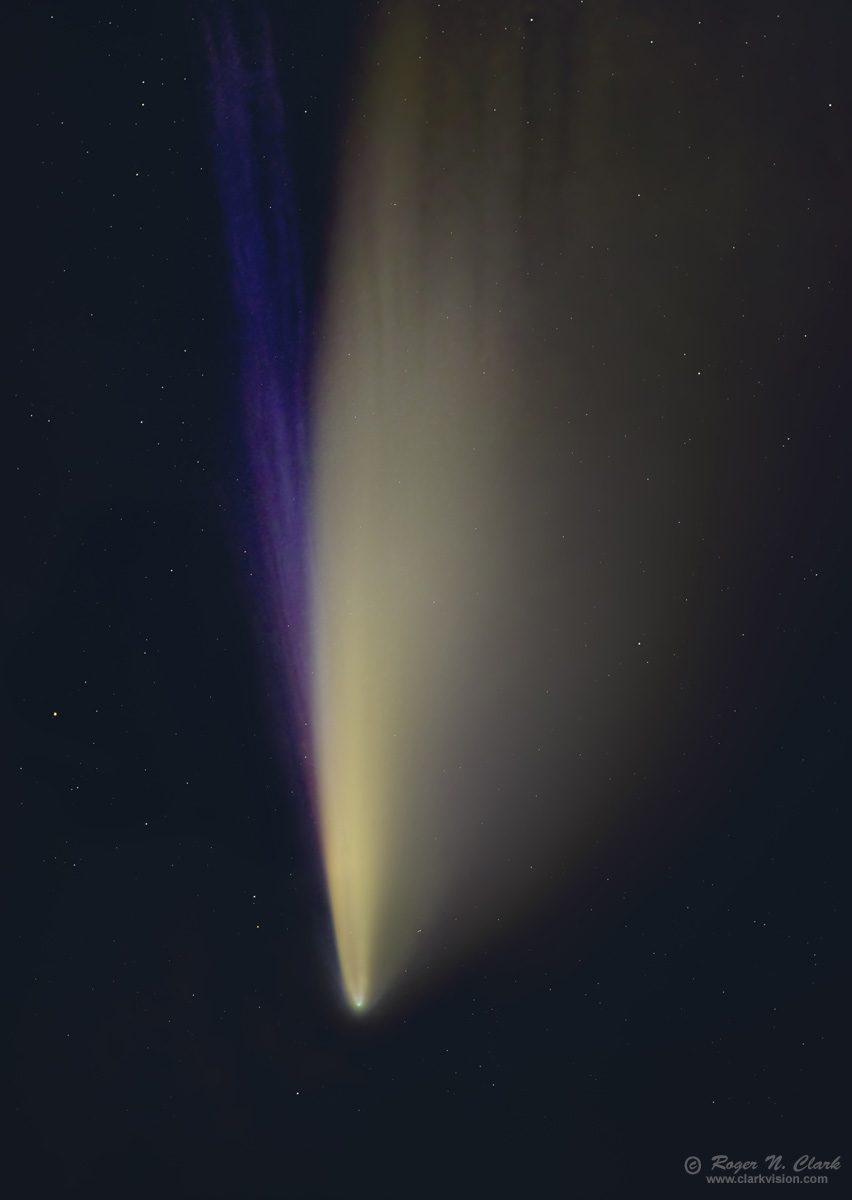| Home | Galleries | Articles | Reviews | Best Gear | New | About | Contact | Gallery Index | Previous |
Next |

| Home | Galleries | Articles | Reviews | Best Gear | New | About | Contact | Gallery Index | Previous |
Next |

Comet NEOWISE put on a dazzling show in the early mornings of July, 2020. The comet was so bright, when it was just barely above the horizon, it was an obvious sight from this moderately dark location at this 10,770 foot elevation dark site in the Colorado Rocky Mountains. It was a beautiful sight in 7x50 binoculars as it rose higher in the sky, with a tail about 4 degrees long (visually), or 8 diameters of the full Moon.
The comet displays two tails: The blue tail (Type 1) is an ion tail. The blue is fluorescence from molecules ionized by solar ultraviolet light. The usual main emission is from CO+ emitting at 425 - 427 nm, deep blue. Comet Neowise also shows sodium emission (589 nm) in the tail (See the Planetary Science Institute Press Release.) Chromaticity of 426 + 589 can produce pink/magenta in the right proportions. The varying hues of magenta and blue along the ion tail may indicate varying proportions of carbon monoxide and sodium emissions. The yellow-ish dust tail (Type 2) is dragged into a fan shape by the solar radiation pressure on tiny dust grains, along with the orbital motion of the comet. The yellow is reflected sunlight off of small dust particles. The green around the nucleus is fluorescence from diatomic carbon (C2) with possible contribution from cyanogen (CN).
Technical. This image was obtained with a stock Canon EOS 90D Camera and Canon 300 mm f/2.8 L IS II lens at f/2.8. Tracking the comet with an Astrotrac, the image is a stack of 55 images. Forty nine 4-second exposures at ISO 800 were stacked for the tails (3.27 minutes total exposure), and 6 images of the comet head with exposures from 1/10 to 0.6 second were combined for a High Dynamic Range (HDR) composite to show detail in from the green nucleus to the faint dust and ion tails. The field of view of the image is 3.9 x 2.8 degrees.
This is a natural color image. Post processing included color preserving methodology, aligned first with Deep Sky Stacker, then stretched with rnc-color-stretch. Also see Astrophotography Image Processing Basic Work Flow. Because the comet moved among the stars during the exposure period, the stars and comet were separated and the comet exposures aligned for stacking, then the image stretched to bring out faint detail. Finally the stars aligned and stacked and added back into the stacked comet image.
Online are images of the comet with a blue ion tail seem to also show a white dust tail. The dust is distinctly yellow brown, both visually and in short exposures with no processing. So images with a white dust tail and blue ion tail are not natural color. They probably set the white balance to tungsten or something similar. The comet is illuminated by the sun, so sunny (daylight) white balance is what is needed for natural color.
The Exposure Factors, CEF, CEFA are measures of the relative amounts of light received from a subject. It can be used to fairly compare wildly different lens/telescope apertures and exposure times. For this image:
Modern DSLRs like the Canon 90D include on sensor dark current suppression and low fixed pattern noise at ISOs around 1600 and higher, making no need for dark frame subtraction. Modern raw converters correct for light fall-off and also correct for hot/dead/stuck pixels. This makes processing low light images easy: simply align and average.
To learn how to obtain stunning images like this, please visit my Extensive Articles on Photography .
Keywords to this image = astrophoto-1 night low-light digital_astro comet canon_90d rnc-color-stretch
Image ID: comet-neowise-rnclark-300mm-c07.10.2020.img_8086-143-av49-.e5-1200vs.jpg
| Home | Galleries | Articles | Reviews | Best Gear | Science | New | About | Contact |
Last updated April 02, 2025